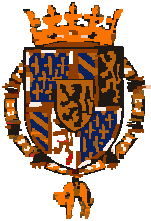
Chivalry
Chivalry was a peculiarity of the practice of war in medieval Europe. It can be likened to the Code of Bushido produced in very similar feudal Japanese society. The feudal knight was supposed to be devout, honest, selfless, just, brave, honorable, obedient, kind, charitable, generous, and kind to women. Sort of a heavily armed Boy Scout . His life was to some extent governed by complex rituals and rules, and he belonged to a quasi-religious international brotherhood.
There were numerous examples of truly chivalrous conduct during the Hundred Years' War. Thus, the Black Prince accorded Jean II of France all the deference due him as a king, even though Jean was a prisoner of war. And Jean, having been released from captivity in England to help negotiate his ransom, voluntarily returned when one of his sons, who had been standing surety for his return, escaped from England. These were deeds celebrated throughout Europe. There was, however, another side to chivalry. Many French --and several English-- defeats in the war can be traced to a bit too much concern for knightly honor, such as Crecy and Agincourt. And, of course, chivalry extended only to certain classes of society. The code did not restrain a person of rank in his dealings with the lower orders.
Operations in which an army treated the local inhabitants with any degree of respect were rare. Henry V was kind to the French commoners as a matter of policy, not chivalry. Henry wanted to win the loyalty of the French people and he was often successful at it. But he was in many ways unusual. More often the march of an army through an area --whether friendly or not-- was marked by looting, arson, rape, torture, murder, and all the other usual atrocities, while hunger and disease brought up the rear. Thus, the Black Prince (Henry Vs great uncle) caused thousands of women and children to be put to the sword during the sack of Limoges. And perhaps 12,000 commoners starved to death between the lines during Henry V's siege of Rouen in 1418-1419, the garrison having driven all the "useless mouths" in the town outside the walls, while the besiegers refused to let them pass their lines of investment.
Much of what has passed down to us regarding chivalry has to do with that aspect of it involving noble men pursuing other mens wives. The "rules" for this game are roughly as follows;
1 Worship of the chosen lady
2 Declaration of passionate devotion
3 Virtuous rejection by the lady
4 Renewed wooing with oaths of eternal fealty
5 Moans of approaching death from unsatisfied desire
6 Heroic deeds of valor which win the lady's heart
7 Consummation of the secret love
8 Endless adventures and subterfuges
9 Tragic denouement
Item 6 was often played out at tournaments , where the lady in question could watch her lover roar through the lists and make his mark jousting. Item 7 often took place the evening after the brave kinght won the tournament. Item 8 involved trying to keep the lady's husband in the dark and item 9 was the result of the husband discovering he was a cuckold.
Like the Code Bushndo, the Code of Chivalry seems to have been honored mostly in the breach.
Orders of Chivalry
During the 14th century, it became quite fashionable for kings and magnates to establish "Orders of Chivalry." Some of these still survive in England. These were not merely high honors. The members of the order were normally expected to stand with the master in battle, as did Sir Thomas Erpingham, chief of the archers at Agincourt.
-Order of the Garter (1348) founded by King Edward III of England.

The ribbon around the shield signifies the status of Order of the Garter. The words Honi soit qui mal y pense mean "Ashamed be he who thinks ill of it."
-Order of the Star (1351), King John II of France founded it in response to Edward's creation of the Garter.
-The Breton Order of Ermine (1382), founded by Duke Jean IV.
-The Golden Apple (1394), Knights of Auvergne and Bourbonnais.
-The Orleanist Porcupine (1396)
-The Golden Shield (1414), The Duke of Bourbon.
-The Dragon (c.1414), The Count of Foix.
-The Prisoner's Chain (1415), The Duke of Bourbon.
-Order of the Golden Fleece (1430), founded by Philip the Good of Burgundy, "From the great love we bear to the noble order of chivalry, whose honour and prosperity are our only concern... and for the furtherance of virtue and good manners." The Dukes of Burgundy placed at the Order's disposal the resources of their enormous wealth. In their view, the order was to serve not only as a symbol of their power; it could also be used to tie together the scattered dominions of the Burgundian state.

The lamb at the bottom represents membership in the Order of the Golden Fleece. This order technically still exists within the gift of the King of Spain (who inherits it through a very complex series of marriages in the early 16th Century), but it has not been awarded n some time.
-The Crescent (1448), Rene of Anjou.
-The Green Shield of the White Lady (?), The 2nd Marshal of Bouccicaut.